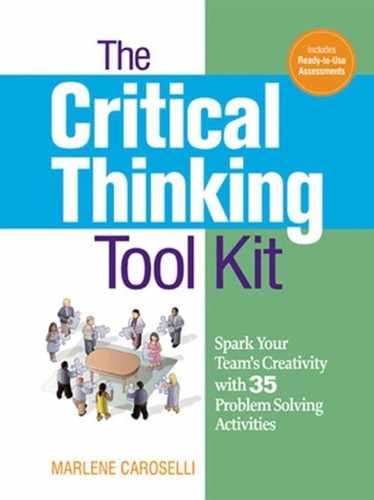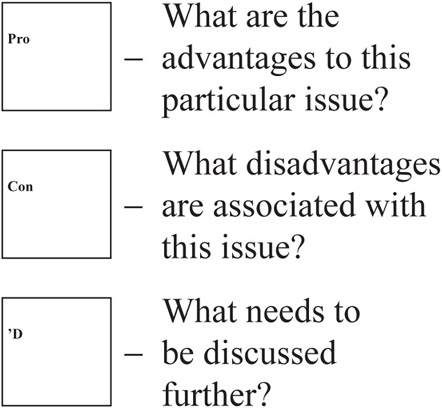#30: Pro Con’D
Overview: |
Participants will first learn how to use this simple analytical tool and then apply it to given issues that affect us as corporate and community citizens. |
Objective: |
To encourage careful and deliberate scrutiny of issues prior to making decisions regarding them. |
Supplies: |
• Transparency #30-1 |
Time: |
Approximately 15 minutes |
Advance |
Download Transparency #30-1. If the training room allows flexible seating, arrange table groups of seven or eight. |
Participants/ |
Any number of participants can use this technique, for any number of issues that arise—either during the course of the training or afterwards in team and staff meetings. If used as a session-opener, the exercise will stimulate lively discussion among participants and so will quickly break the ice that exists among strangers. If used as a concluding activity, the exercise can focus on burning issues that arose during the training program. |
Introduction to Concept:
When we think in a productive fashion, we are able to generalize solutions employed in comparable situations. (Reproductive thinking, by contrast, is merely learning or memorizing correct responses without being able to extend them to similar problems.) Superficial decision-making falls more into the reproductive category than the productive, for it is almost a rote response as opposed to a carefully considered response. [Show Transparency #30-1.] There are numerous techniques that encourage thinking that goes beneath the surface. One such as the Pro Con’D model, which asks the problem-solver to consider:
Pro |
— |
What are the advantages to this particular issue? |
Con |
— |
What disadvantages are associated with this issue? |
’D |
— |
What needs to be discussed further? |
For example, if I asked, “How many of you think the minimum wage should be raised?” most of you would assert that indeed it should be raised. You would probably be able to cite advantages quite readily. Now let me ask, “Would you still want to raise it if I told you that research shows the drop-out rate increases when the minimum wage is increased?”
The Pro Con’D approach puts a halt on our typical and understandable rush to judgment. It forces us to weigh the various consequences that might result from a decision that initially seems quite appealing.
1. Divide the class into teams of six or seven members. Appoint a team leader for each team, whose job will be to ensure that the question has been put to Pro Con’D scrutiny before the “majority-rules” answer (“yes” or “no”) is given.
2. Assign each team one of the following questions (or comparable ones of your own):
1) Should we increase the minimum wage by $2.00?
2) Should we prevent prisoners from filing frivolous lawsuits?
3) Should there be guarantees given when employees are hired? (If so, what should they be?)
4) Should judges instead of juries decide the outcomes of lawsuits?
5) Should organization heads spend more time “walking the talk”?
6) Should the word “secretary” be replaced with something else?
7) Should juveniles committing adult crimes be tried as adults?
8) Should there be a cap on athletes’ salaries?
9) Should there be mandatory training for all supervisors? (If so, what should it consist of?)
10) Should there be a cap on the salaries of CEOs?
11) Should our organization institute a “pay-for-knowledge” system?
12) Should team leaders receive monetary compensation?
3. Allow 10 to 15 minutes for the Pro Con’D assessment of the issue.
4. Call on each group to share the answers they arrived at after the Pro Con’D discussion.
Extending the Activity:
1. Record issues on a flipchart as they arise throughout the training program. Periodically, use the Pro Con’D tool as a format for discussion prior to deciding on a feasible course of action.
2. Scan the newspaper for several days prior to the training program. Write the issues being debated on 3″ × 5″ cards—enough issues so each participant can have one. Have participants select a card, subject the issue to the Pro Con’D technique, and then discuss the issue with a partner, who will then share his or her Pro Con’D views on a different issue with the first person.
1. There are “hot” topics in every workplace. Before you conclude the session, ask participants to write down five issues currently being debated at work. Then ask that they apply the Pro Con’D approach to these issues when they have time for reflection. After culling their own ideas, they should then engage others in a consideration of the issues before decisions are made about them.
2. Suggest that participants contact an arbitrator to learn how he or she is able to bring balance and equanimity of thought to situations that parties feel very strongly about.
Questions for Further Consideration:
1. How can we separate emotions from facts?
2. What has caused some of the arguments that have erupted in your workplace during the last six months?
3. What is the worst decision you ever made?
4. What factors surrounded the making of it?
5. As you reflect upon organizational decisions to proceed in one way or another, do you feel the evidence was given sufficient weight? Explain.

